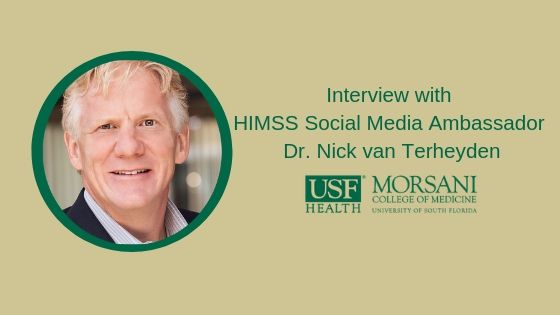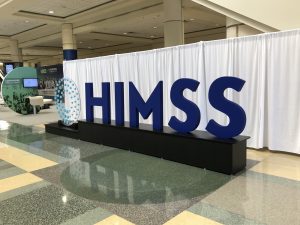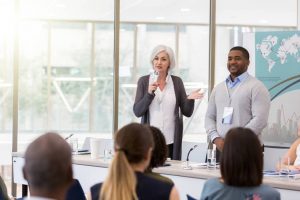Able to blend a medical background with technology expertise at a level few can, Dr. Nick van Terheyden is an industry thought leader in healthcare technology solutions and a sought-after writer and public speaker.
Born in Nigeria, van Terheyden’s career has spanned across borders and healthcare settings. Following his graduation from the Royal Free Hospital School of Medicine at the University of London, he practiced at Britain’s National Health Service (NHS) and later in Australia. But what he found upon starting his work as an emergency room physician was more exhaustion than satisfaction, so he decided to leave the ER behind and pursue a career in healthcare technology.
His decision to do so was not met with congratulations, however, as this was a time when physician burnout was not as openly discussed as it is today.
“I explained to my boss at the time that I was going off to do computer programming, and that part of the reason was some of the challenges I’d experienced at NHS and the 136-hour weeks I was being consumed with,” van Terheyden said. “He turned to me and said that it was a mistake to allow me to get into medical school. That really captured much of the spirit of what was the case in those days for doctors. I continued to practice, but I had some horrific experiences that really affected me and motivated me to go the direction I did.”
He continued to practice medicine, but he did double duty, studying to become a COBOL mainframe programmer. It was unthinkable at the time. His family couldn’t believe what he was doing, but his colleagues widely applauded the decision. Eventually, van Terheyden landed at a healthcare consultancy and launched his journey into medical informatics as a physician and programmer tasked with blending technology, informatics and innovation.
He worked on major projects within the health technology sector, including the development of the first electronic medical record in the early 1990s. Later, he was as a business leader for a company that pioneered speech recognition technology.
A Social Media Early Adopter
These days, van Terheyden is a busy man. He is well-known in the HIMSS community, having worked on the mHealth Taskforce for more than two years before becoming a HIMSS Social Media Ambassador for the last three. He’s also the founder of Incremental Healthcare, his own healthcare consultancy that focuses on small changes that can be applied quickly and effectively, immediately benefiting healthcare organizations and patients alike by reducing cost and increasing access to care.
But one of his biggest passions is social media. He has built a significant following over the years, having jumped on social platforms long before they were standard among healthcare professionals.
“I was a mentor for a group of college students who were doing tours of other countries to experience healthcare around the world, and part of the engagement that was occurring between them was on this social media platform they called Facebook. In those days it wasn’t open if you weren’t a student. And then there was the emergence of this odd 140-character Twitter concept. I wanted to be ahead of the curve and know how to help my kids navigate that world, so I jumped into it.”
In the beginning, van Terheyden was just using social media personally rather than professionally, but he eventually began using it for work purposes. He started experimenting with scheduling tools to help him post regularly and create a consistent presence. He recalls an incident with a former employer who pulled him aside to talk about his tweeting at work.
“The CEO took me to one side to read me the riot act and said he had complaints that I was tweeting during meetings,” van Terheyden said. “I had to explain that it wasn’t actually me, it was technology doing that on my behalf. I’ve found it over the years to be an incredible wealth of resources, so now it’s become a central part of everything I do.”
Becoming a HIMSS Social Media Ambassador
The HIMSS Social Media Ambassador role is something that van Terheyden relishes. It’s a logical extension of everything he’s been doing but allows him to document HIMSS activities and grants him a level of access he may otherwise not have.
But the world of social media is shifting and, as a result, HIMSS is evolving the SMA role with it. For van Terheyden, who was once labeled as one of the top 20 Digital Health Influencers, that evolution is going to be interesting.
“There’s certainly some negative views of social media and I think the concept of influencers is disappearing,” van Terheyden said. “I’ve always been a little bit troubled by the idea of an influencer. I’ve been sucked up into it at times and there’s nothing inherently wrong with that, but I think that HIMSS is trying to innovate in ways that will bring in new voices. I applaud sort of rethinking it and finding new ways to adapt to the age that we’re living in. Hopefully, I can participate in ways that are meaningful for them.”
As a long-time veteran of HIMSS conferences, van Terheyden has seen how the conference has evolved over the years into the massive gathering it is today. His advice to anyone who goes is simple: plan but be ready to adapt.
“You’ve got to be realistic,” he said. “Accept that you can’t do everything, see everything or meet everyone. Most of all, make sure you get a good night’s sleep. I don’t care how brilliant the party is, if you’re staying up all night, you’re not going to get much value out of the following day.”
Read the rest of our chat with van Terheyden below to see what he is looking forward to at HIMSS19 and how he sees the future for healthcare technology.
And don’t forget to come see us at HIMSS19! We’ll be on University Row in kiosk UR12. We’ll also be holding the first Lightning Session of the conference, titled “HomeSense: Ambient Intelligence for Aging in Place,” featuring Dr. Ali Yalcin and Dr. Carla Vandeweerd. The pair will be discussing the platform we examined in Episode One of The Health IT Beat, and how USF Health’s healthcare analytics program teaches students concepts to support projects of its kind.
Q: What are you looking forward to at this year’s conference and what topics do you think will be hot at HIMSS19?
A: “Well the first thing I look forward to every year is exceeding my step count in spades without any effort whatsoever. I regularly exceed 15-20,000 steps without exercise at the conference. But obviously it’s also a chance to reconnect with people. It’s always the networking opportunities and sometimes chance meetings that weren’t planned that offer some real scope for where things are going and what we might see in the future.
“I think we’ll hear a lot this year around security and what I would call augmented intelligence rather than artificial intelligence. That combined with speech is going to create some interesting opportunities around innovation and insights that will help change the way people interact with healthcare technology.”
Q: You’re an SMA as well as a big public speaker. Tell us a bit about what you have going on at this year’s conference.
A: “There’s a number of social media tweetups. One of them is around security, which is a personal passion of mine. I’m always excited to talk about that, and I’m determined to help people understand the emphasis healthcare needs to place on security because a big concern is people are losing trust, and that is one of the most important things we have in healthcare. That’s a panel discussion I’ll be doing.
“There’s also an IoT meetup where I’ll be talking about opportunities for the internet of medical things. The more data we have, the more we can guide people to better decision making. I’ll be working with some clients to do interviews with some experts on the show floor and I’m also looking to promote some events around initiatives that are going on around the opioid epidemic. CHIME is working on a taskforce to raise money along with NTT Data. They’re getting people to take selfies which will be made into a mosaic called “Why I Care.” For every photo, NTT will donate money toward the cause. Anyone who drops by their booth can pick up a sachet of material that was created by a company called Dispose Rx that allows you to take unused medicine, combine it with water, and it makes it into this gel-like substance that makes it inert and inactive. It makes it safe to dispose of and means people can’t abuse it.”
Q: You’re the founder of Incremental Healthcare. Can you tell us a little bit more about this work?
A: “A lot of people talk about exponential change in healthcare. Exponential and incremental are part of the same movement. I think this concept of exponential change is certainly happening; it’s just the cycle time between when we implement changes and then learn from them and course correct just happens faster and faster. That turns into what we would call exponential change. But if you look at an Uber or Airbnb, they weren’t this eureka moment that everybody thinks happens. It turns out it’s full of all these little changes, innovations, thoughts and ideas. What I do is seek out examples in other healthcare systems and industries that have innovated by continuing to focus on implementing small changes. I then help others apply those same ideas in their own space so they can reach that next sort of inflection point for their company or innovation.”
Q: You’ve worked internationally throughout your career and have a broad range of experience in healthcare technology. What do you see as the biggest challenges facing the U.S. in healthcare technology implementation?
A: “If I have an unrealistic hope, it’s that we’ll change healthcare’s design. I don’t think it’s broken: I think it’s working as designed, and we need to change that. But there’s an unwillingness in the current political climate and the polarization of viewpoints to recognize that what we currently have is crippling the vast majority of the population. It only serves a small minority and does so poorly at a high cost. If we don’t change that and return to the roots of what healthcare has always been about, which is fundamentally caring for people, I think we’ll continue to deliver a poor level of healthcare that, when ranked against other countries, puts us anywhere from 23rd down to 54th when you look at efficiency metrics.”
Q: You’re also a whiskey librarian. What does that entail and what is your go-to bottle?
A: “I have a large collection of whiskeys that does now include a broader international range, even bourbons from the U.S. I run tastings for friends locally to allow people to experience the wonderful nature and variability of whiskey from around the world, or just from Scotland even. If I had a go-to bottle, I would tell you it would be an original bottle of Mortlach (Scotch whisky), which these days is very hard to come by.”



